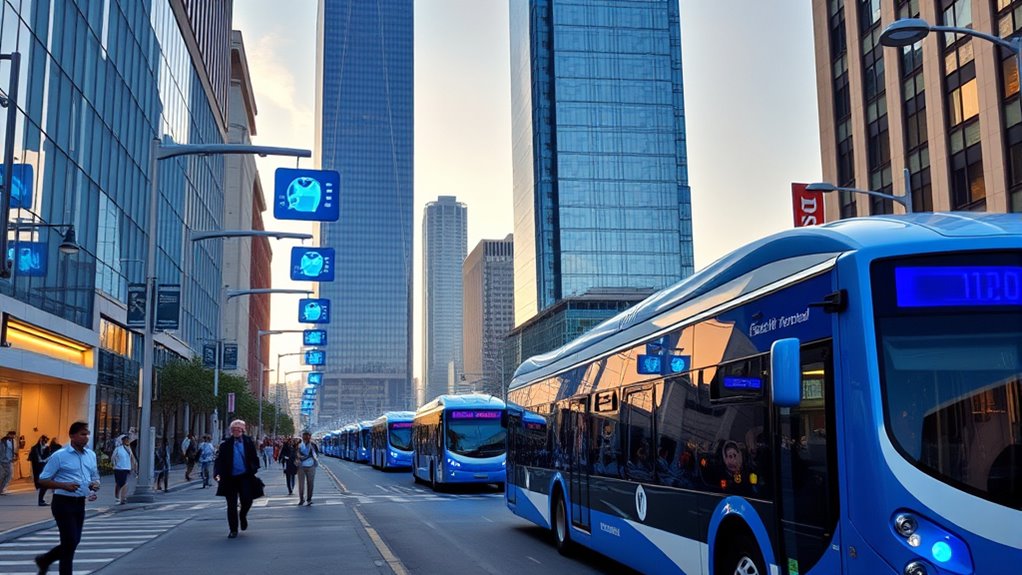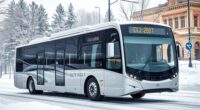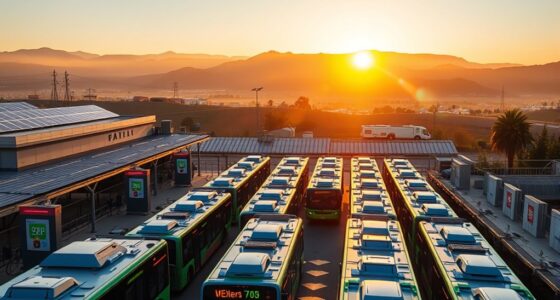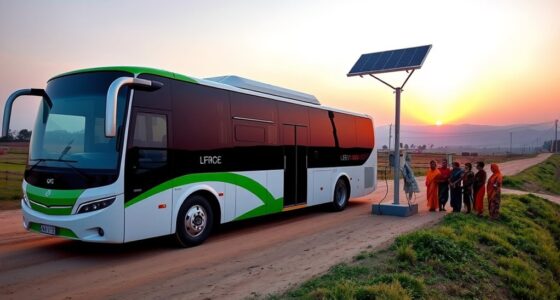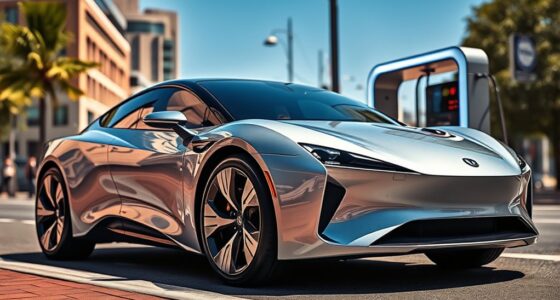Switching to all-electric buses requires careful planning to overcome high upfront costs, infrastructure needs, and evolving technology. You’ll need to secure funding through government incentives and partnerships, plus develop charging stations that fit your routes. Upgrading utility systems and ensuring safety standards are essential. Monitoring advances in battery tech and smart grid solutions can boost efficiency. With strategic investments and process adjustments, your city can lead the way toward cleaner transportation—discover more ways to succeed in this journey.
Key Takeaways
- Securing government incentives and forming public-private partnerships help offset high upfront costs of electric buses.
- Developing strategic charging infrastructure and upgrading utility systems ensure reliable operation and prevent overloads.
- Investing in advanced battery technology and fast-charging options minimizes downtime and extends fleet range.
- Implementing safety protocols, driver training, and data management systems optimize fleet performance and safety standards.
- Strategic planning and infrastructure investments are essential to maximize environmental benefits and ensure long-term success.
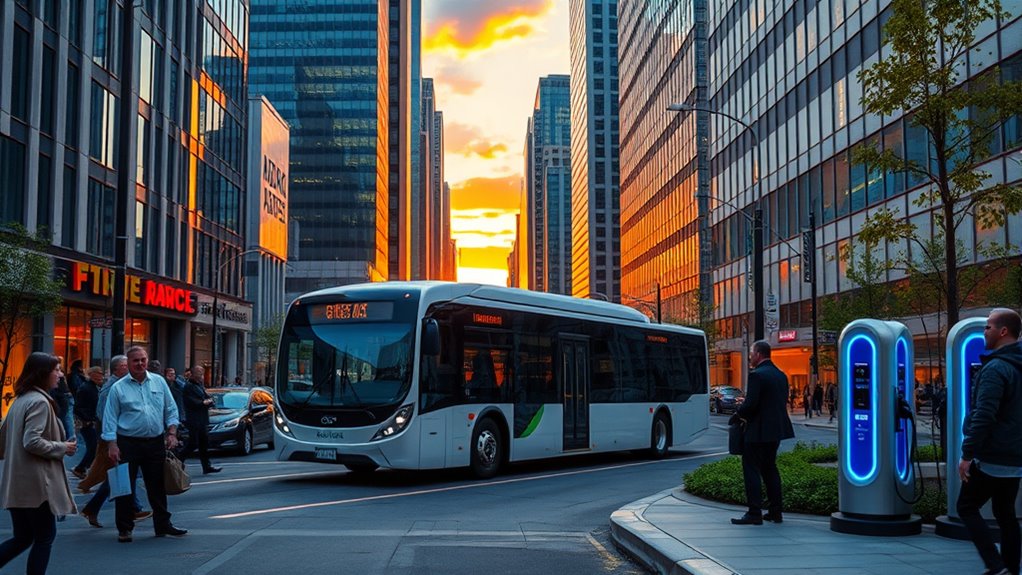
Cities around the world are increasingly shifting to all-electric buses to reduce emissions and improve urban air quality. However, making this transition isn’t straightforward. One of the biggest hurdles you face is the high upfront cost of electric buses. They often cost twice as much as traditional diesel models, which can strain your city’s budget. To manage this, you need to plan carefully, balancing the initial investment with the long-term savings on fuel and maintenance. Securing funding becomes vital, so you’ll likely rely on government incentives or public-private partnerships to help cover these costs. Without additional financial support, justifying the investment can be difficult, especially when budgets are tight.
Transitioning to electric buses reduces emissions but requires careful planning and funding for higher upfront costs.
Furthermore, reallocating existing funds to develop the necessary infrastructure adds another layer of complexity.
Developing charging infrastructure is a critical part of your transition. You’ll need to set up charging stations both at depots and along routes, which requires significant planning and investment. Ensuring your utility system can handle the increased power demand is equally important; overloaded grids can cause delays and increase costs. Depot modifications are often necessary to accommodate charging stations and maintenance facilities tailored for electric buses, which further complicates the upgrade process. Incorporating emerging technological advances such as smart grid integration can help optimize energy use and reduce costs over time. Staying informed about battery technology developments is essential, as improvements can directly impact your fleet’s operational efficiency and range.
Choosing the right charging technology, like fast-charging systems, is essential to keep buses operational and minimize downtime. Integrating these new systems into your existing public transportation network can be complex, as it demands coordination across multiple departments and service routes.
Technological advances also pose challenges. Battery technology is evolving, but you still need to consider range limitations and charging times that impact daily operations. Faster charging speeds are desirable, but implementing them requires investment and compatibility considerations. Additionally, regulatory standards for electric vehicles continue to evolve, influencing procurement and safety protocols.
You must evaluate various electric bus options, including battery-electric and hydrogen-powered models, to find the best fit for your routes. Safety standards are paramount, as electric buses involve different risks compared to traditional vehicles, and establishing effective data management systems helps monitor performance and optimize fleet operations.
Operationally, scheduling becomes more complicated because buses need charging periods, which might require route modifications or new scheduling strategies. Drivers need training to operate and maintain electric buses properly, and maintenance facilities must be adapted to handle new components safely and efficiently. Emergency protocols also need to be updated to address potential issues unique to electric vehicles.
Finally, the environmental benefits depend heavily on where your city sources its energy. If your electricity comes from fossil fuels, the reduction in emissions might be less significant. Despite these challenges, electric buses can dramatically improve air quality in urban areas, making the effort worthwhile.
With careful planning, strategic investments, and ongoing innovation, your city can overcome these obstacles and successfully transition to a cleaner, greener transportation future. Additionally, advancements in projector technology can enhance urban infrastructure projects, making them more efficient and effective.
Frequently Asked Questions
How Will the Transition Impact Local Employment in the Transportation Sector?
The shift to electric buses will substantially impact your local transportation employment. You might see fewer mechanics needed for maintenance, but new roles will emerge in electric vehicle tech, infrastructure development, and renewable energy.
To benefit from these changes, it’s essential that workers receive proper training and support. This change offers opportunities for economic growth and job stability if policies prioritize workforce development and protect existing jobs.
What Are the Long-Term Cost Savings of Electric Buses Versus Diesel?
You’ll find that electric buses offer significant long-term savings compared to diesel. While the initial cost is higher, you’ll save about $73,000 to $173,000 over their 12-year lifespan thanks to lower fuel and maintenance costs.
Plus, they reduce emissions and noise, benefiting the environment and community. These savings and benefits make electric buses a smart investment for your city’s transportation future.
How Will Charging Infrastructure Be Integrated Across the City?
Charging infrastructure is like the backbone of your city’s electric bus system. You’ll need to strategically place stations along key routes, working with city planners and engineers to guarantee seamless integration.
Prioritize standardization for compatibility, upgrade depot infrastructure for fast chargers, and incorporate smart technology for real-time management.
Collaborate with public and private partners, and plan for grid capacity to support future growth, making the shift smooth and efficient.
What Measures Are in Place to Address Potential Technological Failures?
You need to know that multiple measures protect against technological failures. You’re equipped with battery management systems that prevent thermal runaway and detect early issues.
Fire suppression systems delay fires, while automated shutdowns disconnect systems during emergencies.
Redundant safety protocols guarantee continued operation if parts fail. Plus, electrical infrastructure is hardened with surge protection and arc fault detection.
All these steps work together to keep you safe and your buses operational, even when failures occur.
How Does the City Plan to Ensure Equitable Access to Electric Bus Services?
You can facilitate equitable access by prioritizing routes serving disadvantaged communities and involving residents in planning. Using data to identify local needs helps target investments, while partnerships with local organizations support inclusive service.
Developing charging infrastructure in underserved areas and securing funding address financial barriers. Public engagement and workforce training also promote fairness, guaranteeing all communities benefit from cleaner transportation and economic opportunities in the transition to electric buses.
Conclusion
As you see, switching to all-electric buses transforms your city’s transit. With over 1,000 electric buses now on the roads, emissions have dropped markedly, improving air quality for everyone. This journey shows that embracing clean energy isn’t just possible—it’s essential for a healthier future. Your city’s commitment proves that with determination, even big challenges can be overcome, paving the way for sustainable urban mobility. The future is electric, and your efforts inspire others to follow.
